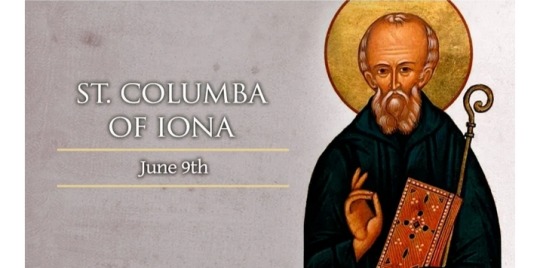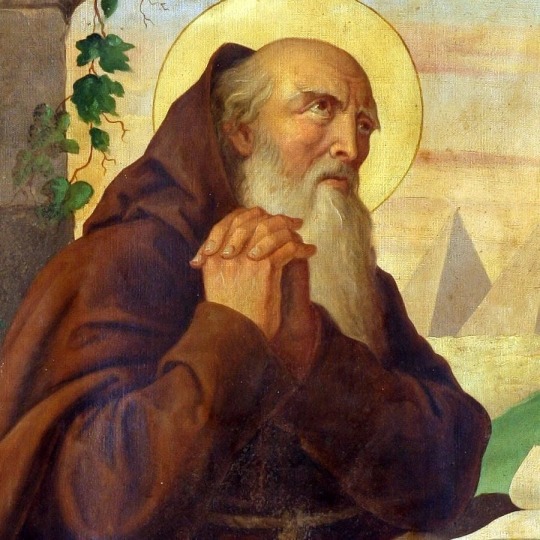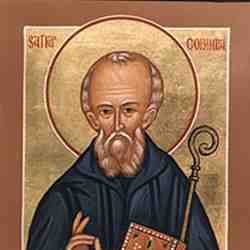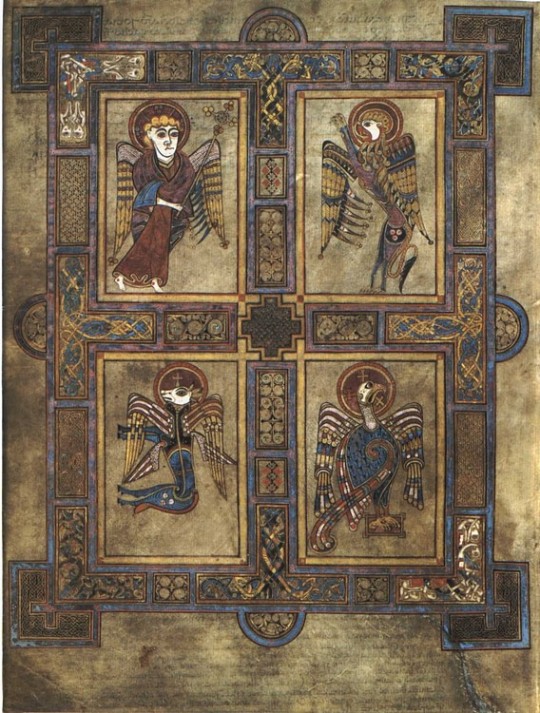#st columba
Explore tagged Tumblr posts
Photo

Saint Columba 521-597 Feast day: June 9 Patronage: Ireland, Scotland, Derry, bookbinders, poets, floods
Saint Columba was born in Ireland of royal descent. He studied for the priesthood under many prominent churchmen, including St. Finnian, eventually becoming abbot. In 563, he sailed to Scotland evangelizing the pagans and establishing monasteries, including the abbey on Iona. Saint Columba is considered one of Irelands 12 Apostles loved by both the Irish and Scots.
Prints, plaques & holy cards available for purchase here: (website)
85 notes
·
View notes
Text
8th June
St Columba’s Day

Colmcille (St Columba) on High. Source: BBC Alba and The Northern Scot website
Today is St Columba’s Day. Despite his saintly title “The Dove of Peace” (Colmcille in Gaelic), Columba had a somewhat violent temperament. A dispute over the authorship of a Psalter with a fellow cleric in his native Ireland led to an actual battle between their respective bands of followers, until the Irish Church intervened and sent Columba off to Scotland to convert the still pagan Picts to Christianity. But bad temper and violence accompanied even his missionary work. Slipping on a flounder one day, Columba is said to have cursed the unfortunate fish, leading to its lopsided appearance. He also dealt with a lecherous Pictish noble by “smiting him with an Angel”. Whereas his victim was suitably stunned, the fate of the angel projectile is not known.
Columba’s most famous exploit was rescuing his followers from the Loch Ness Monster, who in an early fifth century appearance, reared threateningly above two of the saint’s disciplines who were attempting to cross the loch in a small boat. Columba ordered the creature not to harm the men and it slipped away under the surface of the lake and has not harmed anyone since. Columba was a highly successful missionary and based himself on the island of Iona where he developed an almost cult like status.
Apparently Columba wore the flower of St John’s Wort to ward off evil. Apparently it still works.
18 notes
·
View notes
Note
Okay, since we’re talking about St. Patrick and St. Gertrude, I gotta nominate my man St Ailbe.
This man is the patron saint of wolves, which automatically makes him a badass.
He was raised by a she-wolf growing up, and later defended that same she-wolf when he was man. He also raised her pups.
He predates St. Patrick, making him much closer to Celtic Catholicism than other saints.
He has his own church in Emly (which he supposedly built)
Some sources also say he baptized St David aka the patron saint of Wales, making him a big deal.
In conclusion: The Patron Saint of Wolves deserves recognition.
Also, St. Columba cannot be left out of the Irish Apostles.
ahhhh I would have loved to have included St Ailbe and St Columba (Columba was actually on the list) but the pre-schism bracket is almost over!!
Think of new saints for the post-schism, modern, and beatified brackets!
11 notes
·
View notes
Text
Probably my favourite poem right now. Read it, or give it a listen.
youtube
0 notes
Text
Saint Patrick


Ireland
#St Patrick's Day#Ireland#St Columba's Church#Colpe#Eire#patron saint#stained glass#Celtic cross#River Boyne#legend#parish church#Irish history#Feast of St Patrick#Christendom
33 notes
·
View notes
Text



St Columba’s Isle, an ancient burial ground (Isle of Skye, Scotland, 2024)
7 notes
·
View notes
Text
SAINT OF THE DAY (June 9)

On June 9, the Catholic Church commemorates the sixth-century Irish monk and missionary, Saint Columba of Iona, also known as St. Columcille.
One of Ireland's three patron saints (together with Saint Patrick and Saint Brigid), he is also sometimes called the “Apostle of the Picts” for his evangelization of Scotland.
He should not be confused with St. Columbanus (or Columban), a different Irish monk and missionary who lived slightly later and ended up in Italy.
Columba was born during 521, descended from royalty through his father.
He was taught and mentored by the priest who baptized him. He later attended a monastic school founded by Saint Finnian of Moville.
His own life as a monk began at the school where he was also ordained a deacon.
The deacon went on to spend time in a different monastery and school run by another Finnian, Saint Finnian of Clonard.
Columba became a priest during this period, and along with eleven others from this same institution, he would be known as one of the “Twelve Apostles of Ireland.”
Columba also studied with Saint Mobhi of Glasnevin, before a disease epidemic forced him to return to his ancestral homeland of Ulster during 544.
He spent the next 15 years traveling, preaching, and founding monasteries.
In 563, it is not clear why Columba left Ireland. By some accounts, he was simply going to preach the word of God.
Others claim that he had become involved in a battle between warring tribes, before repenting and taking on foreign missionary work as a penance.
On the island of Iona, located on Scotland’s northwest coast, Columba and his group of companions built simple monastic quarters and a church for themselves.
The priest-monk’s first missionary work was in the region of Dalriada, whose Celtic Christian inhabitants were lacking solid religious instruction.
His next effort was to convert the Picts of northern Scotland, a task that would take up most of the rest of his life.
He began by gaining entrance to the castle of King Brude, where the locked gates are said to have miraculously opened when the sign of the Cross was made.
The king welcomed the missionaries, believed the Gospel, and was baptized.
Columba’s evangelization of northern Scotland continued over the next three decades.
He and his companions met with some resistance from the native pagan Druids, but on the whole, they found remarkable success in spreading the Catholic faith and building up a network of churches and monasteries.
The island monastery at Iona remained his home base. It drew pilgrims looking to benefit from the priest-monk’s wisdom and his prayers.
He remained in touch with the Irish Church, making many trips back until he became too weak to travel.
Even in old age, Columba maintained an intense routine of prayer, fasting, and study.
After giving a final blessing to his monastery on 8 June 597, he died sometime in the early hours of the following day.
#Saint of the Day#Saint Columba of Iona#St. Columcille#Apostle of the Picts#Twelve Apostles of Ireland
4 notes
·
View notes
Text
#OTD in Irish History | 22 August:
565 – St Columba reports seeing a monster in Loch Ness, Scotland. 1755 – Birth of General Jean Joseph Amable Humbert. He was a French soldier, a participant in the French Revolution, who led a failed invasion of Ireland to assist Irish rebels in 1798. 1791 – Theobald Wolfe Tone publishes “An argument on behalf of the Catholics of Ireland”. 1798 – Birth of doctor, writer, abolitionist and…

View On WordPress
#irelandinspires#irishhistory#OTD#22 August#Bandon#Beal na mBláth#Catholic Synod#Clonakilty#Co. Cork#General Jean Joseph Amable Humbert#History#History of Ireland#Ireland#Irish Civil War#Irish History#Irish War of Independence#Jimmy Barry Murphy#John Keegan Casey#Loch Ness#St. Columba#Theobold Wolfetone#Today in Irish History
10 notes
·
View notes
Text
27th October
St Odran’s Day

Source: AnaStPaul website
Today is St Odran’s Day. Odran was a sixth century Irish bishop and missionary who was a close companion of St Columba. The legend surrounding his death is one of the most extraordinary of that of all the early Christian saints. Columba built a new church on the island of Iona, but its foundations would not take. The only remedy for the collapsing building Columba could come up with was human sacrifice. Odran, by now an elderly man and who had long debated the nature of the afterlife with his mentor, volunteered to be the sacrificial victim, reasoning that this way he would find out the truth about Heaven and Hell. Odran was duly buried alive in the church’s new foundations. Sure enough, afterwards, the building stayed intact, so Columba ordered that Odran be retrieved from the ground. The monks dug and revealed the saint’s head, which immediately began talking, giving the nuanced message that Heaven was not all that it was cracked up to be and that the denizens of Hell were not universally miserable. Columba immediately brought an end to this heretical revelation by ordering the monks to cover his friend’s head before he could say any more.
Hunan sacrifice was most definitely not part of Christian tradition, but pagan religion frequently ensured the safety of new buildings by the killing of animals (and presumably before that, of humans) and burying them in the foundations. One can only assume that the story of Odran’s death was a repurposed pagan Celtic tale, which makes it a genuine curiosity. The fact that the story has a philosophical aspect only makes more intriguing.
This month also saw the brewing of the mighty October Ale in households across the British Isles. Fabulously strong, it was only brought out rarely in the autumn and winter months to warm the bellies of its drinkers, being kept locked away for the rest of the time.
2 notes
·
View notes
Text


About St Barbara
About St Columba
PRE-SCHISM BRACKET ROUND 1
#st barbara#st columba#catholic saint tournament#catholic#catholicism#catholic saints#tumblr bracket#christianity#tumblr tournament#polls#theology#tumblr polls
8 notes
·
View notes
Text
A Special Light
I’m not writing about Israel today, but I hope you’ll see the connection. Teaching in a small Christian college brought many special dividends. Students came from around the world and lived in our homes instead of in dorms. Sometimes their families also visited, stayed with us, and we became friends. When I could manage air tickets to their homelands (or had airmiles) I was part of their extended…

View On WordPress
0 notes
Text


ST. COLUMBA'S SALMON (6th c., 15th c.)
Despite most of my time being taken up by watching various Euro Cup games (since Germany is hosting, the atmosphere in my neighbourhood is electric!), I did find some time this weekend to make my next Tasting History dish, St. Columba's Salmon. This recipe is inspired by Saint Columba, who fled Ireland in the 6th century (after some literary drama) to settle on Iona, an island off the coast of Scotland. He established an abbey there, performing miracles and prophesying the deaths of people and animals in the vicinity. Seafood would have been a mainstay for Saint Columba, and because we don't have any recipes from St. Columba's life and times, this salmon dish is made up of recipes from later on in the Middle Ages which include the ingredients that would have been available in Columba’s time on Iona, the only imports being pepper and wine. I chose to make this recipe partly in honour of all the amazing Scottish football fans who have made our Euro Cup viewings memorable in the best of ways here in Germany, and also because salmon is a favourite dish of mine. See Max’s video on how to make it here or see the ingredients and process at the end of this post, sourced from his website.
My experience making it:
I made a couple changes to the modern recipe below. The big one: I pretty much disregarded the recipe for making the salmon because, to me, the idea of boiling salmon in wine is a disrespect to both the salmon and the wine. So, I pan-fried the salmon instead with a small amount of dill, as dill is my favourite way to season it. For the wine in the sauce, I used a German dry riesling, and for the bread, I used a classic French baguette.
Despite only following the sauce part of the recipe, it still took awhile to make, mostly because of the amount of chopping and pounding with the mortar and pestle for the herbs. I don't think I got quite as smooth of a paste as Max did, but fairly close. The bread soaked up the vinegar almost too well. When I added the herb paste and soaked bread bits into the white wine, I quickly realized the amount of white wine called for seemed way too much - even after mixing, the sauce seemed terribly thin. As a result, I added more soaked bread, but it was still too thin. I eventually achieved the consistency of Max's sauce by putting the mixture through a sieve, then adding back in a small amount of the liquid. The sauce finally looked like it was supposed to, so after pan-frying the salmon and adding a side of peas and leftover baguette with butter, I served it forth!
My experience tasting it:
I first tried the sauce by itself, partly in order to see how much I should put on the salmon. Honestly, the sauce tasted mostly of vinegar, with only a slight flavour of herbs at the end. So, I only put a little bit of the herb sauce on the salmon in order to not overpower the flavour of the salmon. My first bite of the sauce on the salmon was also a little too vinegary for my liking. The texture and flavour of the salmon was, as always, delicious, but the sourness of the sauce really spoiled a lot of the flavour. I think the herb notes at the end were quite delicious with the salmon, though, so if I were to make this sauce again, I would probably soak the bread in water instead of white wine vinegar. The sauce's texture was also a little bit more like a dressing than a sauce, so I could see it working well on something other than salmon. My husband and I agreed that we will not make this recipe again. For the amount of work and time it takes to make the sauce, the result overpowered the salmon and seemed like a waste of good parsley, good wine, and good French baguette. I was unpleasantly surprised regarding this, since Max seemed to really like this dish and said he would consider making St. Columba's Salmon as a modern recipe today. However, for us, it was a flop. Maybe I went wrong somewhere in preparing it; maybe by putting the sauce through a sieve, too much wine was removed, leaving only the vinegar taste behind. Oh well. If you end up making it, if you liked it, or if you changed anything from the original recipe, do let me know!
St. Columba's Salmon original recipes (15th c.)
Sourced from Registrum Coquinae, c. 1430, and Liber Cure Cocorum, c. 1430, respectively.
If you want to simmer salmon, add wine and parsley, and it will be good. For verde sawce Take parsley, thyme an ounce, and grind, Take white bread grated by kind Mix all up with vinegar or wine, Season it with powder of pepper fine.
Modern Recipe
Based on Registrum Coquinae (c. 1430), Liber Cure Cocorum (c. 1430), and Max Miller’s version in his Tasting History video.
Ingredients:
Salmon:
1 750 ml bottle of white wine
2 pounds (1 kg) wild salmon
A handful of torn parsley leaves
Water
Salt and pepper
Sauce
A large handful of flat leaf parsley
2 tablespoons fresh thyme
1 slice of bread with no crust
1/2 teaspoon pepper
A few splashes of white wine vinegar
Method:
For the salmon:
Reserve 1/2 cup (120 ml) of the wine for the sauce and pour the rest into a large pot.
Add the parsley and then enough water so that the liquid will cover the salmon.
Bring the liquid to a boil, then reduce the heat and let the temperature drop to about 175°F (80°C). A candy thermometer is helpful for this.
Add the salmon to the pot and let it cook undisturbed for 10 minutes.
For the sauce:
Chop the parsley as finely as possible. Grind the parsley and thyme in a mortar and pestle until it becomes a paste.
Soak the bread in the vinegar, then add a bit to the herbs. You’re not going to need much bread. Grind the bread with the herbs until it’s nice and smooth, then transfer it to a bowl and add in the 1/2 cup of reserved wine to make a sauce.
Add the pepper and set it aside. If you want a thicker sauce, you can grind up more of the bread and add it in.
To serve:
After 10 minutes, take the salmon out of the poaching liquid and let it cool. You can eat it warm, but Saint Columba probably would have eaten it at room temperature or even cold.
Sprinkle the salmon with salt and pepper, pour the sauce over the fish, and serve it forth.
#tasting history with max miller#tasting history#medieval meals#max miller#cooking#europe#15th century#6th century#salmon#fish#sauces#herbs#St. Columba#Scotland#historical cooking#Liber Cure Cocorum#Registrum Coquinae#failed attempts#great britain#pescatarian recipes
0 notes
Video
Old Saint Paul Minnesota Postcard Collection - The Church Of St. Columbia, 1327 Lafond Avenue , Circa 1960s by Joe Haupt
#Old Saint Paul Minnesota Postcard Collection#The Churches Of Old St. Paul Minnesota#St. Columba Roman Catholic Church St. Paul Minnesota#Vintage Postcard Collection#Vintage St. Paul Minnesota Postcards#flickr
0 notes
Photo

Book of Kells
The Book of Kells (c. 800) is an illuminated manuscript of the four gospels of the Christian New Testament, currently housed at Trinity College, Dublin, Ireland. The work is the most famous of the medieval illuminated manuscripts for the intricacy, detail, and majesty of the illustrations. It is thought the book was created as a showpiece for the altar, not for daily use, because more attention was obviously given to the artwork than the text.
The beauty of the lettering, portraits of the evangelists, and other images, often framed by intricate Celtic knotwork motifs, has been praised by writers through the centuries. Scholar Thomas Cahill notes that, “as late as the twelfth century, Geraldus Cambrensis was forced to conclude that the Book of Kells was “the work of an angel, not of a man” owing to its majestic illustrations and that, in the present day, the letters illustrating the Chi-Rho (the monogram of Christ) are regarded as “more presences than letters” on the page for their beauty (165). Unlike other illuminated manuscripts, where text was written and illustration and illumination added afterwards, the creators of the Book of Kells focused on the impression the work would have visually and so the artwork was the focus of the piece.
Origin & Purpose
The Book of Kells was produced by monks of St. Columba's order of Iona, Scotland, but exactly where it was made is disputed. Theories regarding composition range from its creation on the island of Iona to Kells, Ireland, to Lindisfarne, Britain. It was most likely created, at least in part, at Iona and then brought to Kells to keep it safe from Viking raiders who first struck Iona in 795, shortly after their raid on Lindisfarne Priory in Britain.
A Viking raid in 806 killed 68 monks at Iona and led to the survivors abandoning the abbey in favor of another or their order at Kells. It is likely that the Book of Kells traveled with them at this time and may have been completed in Ireland. The oft-repeated claim that it was made or first owned by St. Columba (521-597) is untenable as the book was created no earlier than c. 800, but there is no doubt it was produced by later members of his order.
The work is commonly regarded as the greatest illuminated manuscript of any era owing to the beauty of the artwork and this, no doubt, had to do with the purpose it was made for. Scholars have concluded that the book was created for use during the celebration of the mass but most likely was not read from so much as shown to the congregation.
This theory is supported by the fact that the text is often carelessly written, contains a number of errors, and at points certainly seems an afterthought to the illustrations on the page. The priests who would have used the book most likely already had the biblical passages memorized and so would recite them while holding the book, having no need to read from the text.
Scholar Christopher de Hamel notes how, in the present day, “books are very visible in churches” but that in the Middle Ages this would not have been the case (186). De Hamel describes the rough outline of a medieval church service:
There were no pews (people usually stood or sat on the floor), and there would probably have been no books on view. The priest read the Mass in Latin from a manuscript placed on the altar and the choir chanted their part of the daily office from a volume visible only to them. Members of the congregation were not expected to join in the singing; some might have brought their Books of Hours to help ease themselves into a suitable frame of mind, but the services were conducted by the priests. (186)
The Book of Kells is thought to have been the manuscript on the altar which may have been first used in services on Iona and then certainly was at the abbey of Kells. The brightly-colored illustrations and illumination would have made it an exceptionally impressive piece to a congregation, adding a visual emphasis to the words the priest recited while being shown to the people; much in the way one today would read a picture book to a small child.
Continue reading...
466 notes
·
View notes
Text

St Columba's Free Church of Scotland.
Edinburgh Scotland
Red doors in Feng Shui are a sign of positive energy, prosperity and good luck. Cheers and may your day be filled with all this positive energy.
9/24
Posted 1/25
132 notes
·
View notes









